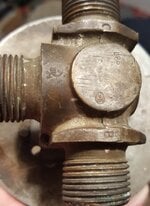Thank you for this information, I have been checking this track and the raids on Sttetin: 29/30 09.1941 participation of 10 Stirling's from 7 Squ. 2 missing, one crashed in Jutland, the other missing.Bomber Command did not send Stirlings on operations to Poland, only Lancasters went as far east as Gdynia. Danzig was to the east of Pomerania. There were two obvious targets in Pomerania, Swinemunde and Stettin but Stettin was close enough to Berlin that aircraft sent to Berlin reported attacking Stettin and plenty of Stirlings were sent to Berlin, with 64 reported losses.
When the target was actually Stettin, 29 September 1941, W7433 lost over the North Sea, W7441 shot down over the Little belt in Denmark, 20 April 1943, R9621 and BF506 reported missing, R9621 coming down at Kongsmark Denmark and BF506 SW Horsens Denmark.
On 11 October 1942 R9190 sent to lay mines off Swinemunde, shot down off Denmark.
At this point in time if the parts were definitely only fitted to a Stirling the aircraft was probably well off course when it came down, which means there are plenty of possibilities to check.
20/21.04.1943 11 Stirlings, 1 lost over Denmark.
29/30 04.1943 ?
18/19 07.1943 ?
5/6 01. 1944 ?
I don't think any were lost over Kashubia, as that is the name of the region where this element was obtained. My question is did the Stirlings have autopilot ? Is there a possibility that they flew that long without a crew.




